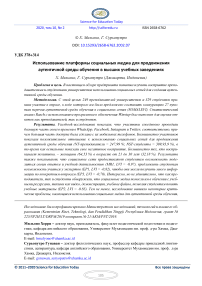The use of social media platform to promote authentic learning environment in higher education setting
Автор: Mulyono Herri, Suryoputro Gunawan
Журнал: Science for Education Today @sciforedu
Рубрика: Математика и экономика для образования
Статья в выпуске: 2 т.10, 2020 года.
Бесплатный доступ
Introduction. This current survey attempts to explore university teachers and students’ perception of using social media to promote an authentic learning environment. Materials and Methods. To this end, 249 university teachers and 329 students participated in the survey where they were asked to compete of 27 items of A Social Media Authentic Learning Environment Inventory (SOMALEVI). Statistical Rasch analyses using Winstep software were performed to evaluate both teachers and students’ responses. Results. Findings of the study showed that participants spent most of their time daily on WhatsApp, Facebook, Instagram and Twitter, respectively with most access was made from their mobile phones. Most of the participant showed positive views about the use of social media to promote authentic learning environment (Nteachers = 247, 99 %; Nstudents = 309, 93.9 %) while the rests showed their negative perception. The majority of those who perceive positive are female (64.53 %) aged range 21-30 years (32.18 %). Findings also indicate that social media provided opportunities for students to share their experiences and learning activities (MR1, LVI = -0.97), to offer students the opportunity to learn from experts (EP1, LVI = -0.82) so that they were able to obtain a lot of insight on particular issues (EP3, LVI = -0.70). It is interesting, but not surprising that both teachers and students found that social media benefited them with learning resources such as video, demonstration, learning files, allowing students to comprehend the learning materials (EP2, LVI = -0.85). However, the study identified some critical issues regarding the use of social media for authentic learning environment, such as unsuitable real-life representation, difficulty to collaborate with others, and difficulty in recognizing their learning potential. Conclusions. Social media is an alternative mobile technology that facilitate teachers and students with the creation of an authentic learning environment.
Mobile technology, social media, authentic learning, authentic environment
Короткий адрес: https://sciup.org/147230524
IDR: 147230524 | УДК: 378+314 | DOI: 10.15293/2658-6762.2002.07
Список литературы The use of social media platform to promote authentic learning environment in higher education setting
- Gikas J., Grant M. M. Mobile computing devices in higher education: Student perspectives on learning with cellphones, smartphones & social media // Internet and Higher Education. 2013. Vol. 19. Pp. 18-26. DOI: 10.1016/j.iheduc.2013.06.002
- Vázquez-Cano E. Mobile distance learning with smartphones and apps in higher education // Educational Sciences: Theory and Practice. 2014. Vol. 14 (4). Pp. 1505-1520. URL: https://eric.ed.gov/?id=EJ1045122
- Husbye N. E., Elsener A. A. To move forward, we must be mobile: Practical uses of mobile technology in literacy education courses // Journal of Digital Learning in Teacher Education. 2013. Vol. 30 (2). Pp. 46-51. DOI: 10.1080/21532974.2013.10784726
- Parker J., Maor D., Herrington J. Authentic online learning: Aligning learner needs, pedagogy and technology // Issues in Educational Research. 2013. Vol. 23 (2). Pp. 227-241. URL: https://www.researchgate.net/publication/257308425_Authentic_online_learning_Aligning_learner_needs_pedagogy_and_technology
- Herrington J., Oliver R. An instructional design framework for authentic learning environments // Educational Technology Research and Development. 2000. Vol. 48. Pp. 23-48. DOI: 10.1007/BF02319856


